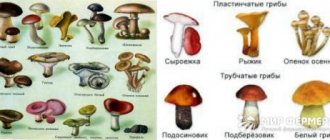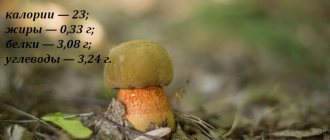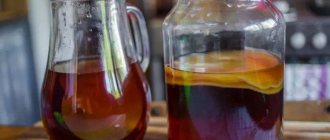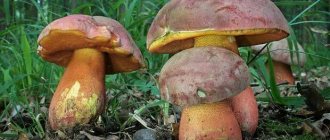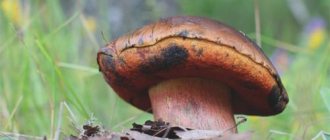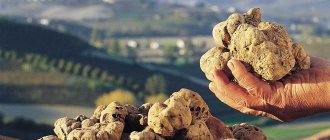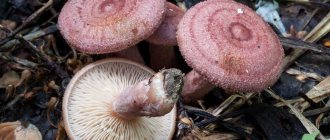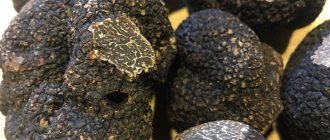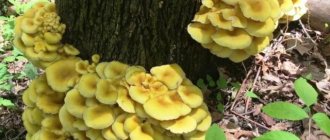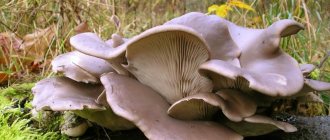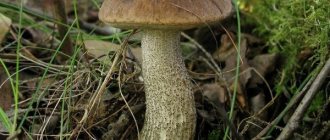Short description
| Type of mushrooms: | edible |
| Other names (synonyms): | Boletus granulidae, Boletus red-legged |
| Latin name: | Boletus erythropus |
| Family: | Boletaceae |
| Distinctive feature: | Speckled oak mushroom: its cap has a very modest color, but the brightest leg allows you to recognize it from many other mushrooms. |
| Beginning of the season: | August |
| End of season: | September |
| Leg height (cm): | 5—15 cm |
| Cap width (cm): | 5—20 cm |
| Smell: | not expressed |
| Taste: | not distinctive |
| Tasting score: | [kkstarratings] Have you tried this mushroom? Then rate it! |
| Hat: | initially hemispherical, later cushion-shaped. In fine weather, the surface is velvety to the touch, dry, matte, but in rainy season it can become covered with mucus. The caps of adult fungi sometimes become smooth. Dark brown, dark brown, brown-chestnut and even sometimes black-brown. If you press on the surface of the hat, it will darken to blackness. |
| Leg: | 2-3 cm thick, tuberous, barrel-shaped, later thickened towards the base, yellow-red with spotted small dark red scales, speckles, solid or complete. |
| Hymenophore (bottom of cap): | the tubes are yellow, later yellow-olive, olive, greenish-yellow, the pores are rounded, small, yellow, later orange, brick-red, turning blue when pressed. |
| Disputes: | fusiform, smooth, 15 × 5 µm. |
| Pulp: | dense, fleshy, bright yellow, reddish in the leg, quickly turns blue when cut. |
| Natural environment and mycorrhiza: | in coniferous and deciduous forests with oak, fir, beech trees and fir trees. More often found in acidic soils, marshy and mossy areas. |
| False doubles: |
|
| Growing: | – |
| Use: | Use as food after boiling for 15 minutes, then drain the broth. |
| Medicinal properties: | – |
| Spreading: | in Europe, the Caucasus, Eastern Siberia, less often in Western Siberia and the south of the Far East. |
Nature has created a huge number of delicious delicacies for humanity. Among them, mushrooms also occupy a large niche. One of the widely used ones is speckled oak.
Speckled oakweed: photo and description
Speckled Oak (Boletus erythropus) belongs to the Boletus genus, Boletaceae family, and is edible. Popularly it has many synonymous names, for example, oak boletus, granular boletus, bruise, red-legged boletus. You can recognize it by its rounded, voluminous cap, orange-red color and barrel-shaped stem.
Important! When cutting a mushroom, you need to leave the rhizome in the ground. If you pull out the plant completely, it will no longer grow in that place.
Description of the characteristics of speckled oakwood:
- cap diameter - from 5 to 20 cm;
- leg height - from 5 to 15 cm;
- the cap is brown, velvety, without shine;
- the leg is dense, up to 4 cm in diameter;
- upon close examination, red dots or a semblance of a red fine mesh are visible on the stem.
The general impression of the oak mushroom: a massive, squat, large mushroom. To inexperienced mushroom pickers, it may appear similar to white, but with a cushion-shaped cap. The pulp has a faint yellow tint and begins to turn blue immediately after cutting.
Cooking recipes
Speckled oakberry is widely used in cooking. It is easy to process and tastes good.
Beneficial features
The mushroom contains:
- iron (normalizes hemoglobin levels in the blood);
- zinc (improves digestion and absorption of nutrients);
- copper (participates in the division of pituitary cells, participates in the processes of blood formation);
- beta-glutens (strengthens the immune system);
- the mushroom contains vitamin B, D, PP, C, A.
Consumption of this type of mushroom supports the functioning of the heart and blood vessels, and normalizes blood pressure.
It acts on the human body as an antioxidant, antiviral and anti-inflammatory agent. Resists the occurrence of neoplasms of any type.
Cleaning
Cleaning of debris and soil involves washing with water. Remains of adhered foliage and pine needles are removed manually. If there are any damages, they are cut out with a knife.
Boiling
Boil the mushrooms in salted water for no more than 25 minutes, wash and re-send for cooking.
Pickling speckled oak
To prepare you will need:
- 1 kg of pods;
- 9 percent vinegar (2 tbsp);
- citric acid on the tip of a knife and marinade.
For the marinade:
- 200 ml water;
- black peppercorns (5 peas);
- according to Art. l. sugar and sea salt;
- 3 cloves of garlic;
- Bay leaf;
- a few sprigs of dill and cloves.
Peeled mushrooms are cooked according to the rules, excess liquid is drained through a colander and cooled. At the same time prepare the marinade. Add spices, salt, sugar to boiling water and continue boiling for 5 minutes. Place the mushrooms in the pan for another 5 minutes. Place the oak leaves with the marinade in a jar, add vinegar and cover with a lid.
Freezing
For winter storage, strong specimens are selected, cleaned, and the lower part of the stem is cut off. You cannot soak mushrooms of this type; the sponge will become watery and lose its elasticity.
The fruits are cut into small pieces and placed on a flat surface (tray, board), and placed in the freezer for 3-4 hours. Only after this are they formed into bags and returned to the freezer.
Important! The air from the bag must be removed. This action will help slow down the aging process.
Roasting oak wood
The taste is very similar to porcini mushrooms. A suitable side dish is potatoes. To prepare you will need:
- potatoes – 5–7 medium-sized pieces;
- boletus – 200 g;
- garlic – 2–3 medium-sized cloves;
- salt - tsp;
- onions (green or onions); pepper, dill, parsley, spices - to taste.
Place butter in a heated frying pan, followed by boiled poddubnik mushrooms with chopped onions.
Where does it grow
The ideal habitat of the speckled oak is deciduous forests, oak groves, coniferous plantations and undergrowth, as well as mixed forest belts with a large number of spruce, oak, pine, fir and beech trees. The territorial distribution of the fungus is quite wide: the entire Caucasus, Eastern Siberia, Far East, Europe . It loves acidic soils, plenty of moss, partial shade and dampness.
Did you know? The oldest mushroom discovered on the planet is 400 million years old!
So is it possible or not to eat the satanic mushroom?
The main question is – why? Only a few who tasted Boletus Satanas found it pleasant. Most experimenters claim that it is very bitter, and if you mix it in a frying pan with normal mushrooms, everything will become bitter because of it. The bitterness, of course, can be masked with garlic or other tricks, but there is simply no point in dodging it like that - unless it’s just for the sake of the desire to taste the Devil’s Mushroom. This mushroom does not contain any useful healing substances that would be worth risking your health for, but predicting your stomach’s reaction to it is very difficult.
In most countries, the Satanic Mushroom is considered inedible or mildly poisonous. In some places it is classified as conditionally edible, but this does not really change the essence of the matter.
Therefore, we advise you, in the event of a collision, during a quiet hunt, with this beautiful creation of nature, just admire it and take a photo as a souvenir. It makes sense to eat this mushroom only in a situation where you are irretrievably lost in the forest, and you simply have nothing else to eat besides it. In this case, you should remember the main rule:
Under no circumstances should the Satanic Mushroom be consumed raw, otherwise you are guaranteed a severe stomach upset with the most unpredictable consequences.
When to collect
The growth period of speckled oak is quite long: from May to October. It is better to time the harvest in July, since at this time the maximum level of fruiting is observed. By October, some mushrooms become too large and empty inside, and they are difficult to process when they outgrow the average size.
To collect, use a small sharp knife, which is used to carefully cut off the boletus and place it in a storage container. This can be a wicker basket or an enamel bucket.
Consequences of the appearance of white house fungus
The white house fungus most often affects wooden floors and beams at the base of buildings, and paint on the floor is not a protection. At first it looks like white mold. The spores quickly penetrate deep into the wood using mycelial cords, which are designed in such a way that they loosen large areas of the wood. After this, the affected tree becomes extremely fragile and breaks under any pressure.
The material begins to easily absorb water, humidity increases, providing a favorable environment for the further development of the fungus. In this case, water can further weaken the structure. The affected areas of walls and floors can be easily pierced with a penknife.
Often the owners of wooden houses wonder how to destroy the mycelium of the fungus, which has been living in buildings for a long time, once it has taken up residence. It's difficult to get it out. To get rid of the house parasite, entire structural elements are cut out, including large beams and boards. To prevent it from developing again indoors, it is necessary to dry the structure by significantly reducing air humidity.
Growing
Like other mushrooms, granular boletus reproduces by spores. And yet, growing such mushrooms at home is a very difficult process. It is recommended to harvest in the forest, on large areas of moss, in an ecologically natural environment. For those new to the mushroom business, it would be a good idea to look at photos of false oak mushrooms and find out their names.
Important! Heat treatment removes toxins from mushroom tissue, so double cooking with changing water during preparation is mandatory.
The false boletus species include the following relatives:
- satanic mushroom (does not differ from the real one in shape, but has a white color and turns blue when cut);
- oak tree Kele (it is easily recognized by its smooth brown stem, without red dots, as well as by its dry and smooth cap).
Examples
It is difficult for an inexperienced mushroom picker to distinguish these species from edible fruiting bodies. They have no special differences. To recognize them, it is worth studying the descriptions of category representatives.
Autumn oyster mushroom
Fruiting lasts from mid-autumn to mid-winter. The largest harvest is harvested during thaws, when the ambient temperature is 4-6 °C. It grows on deciduous wood: aspen, alder, birch, poplar, and less often on coniferous plants. Occurs in groups.
Worms do not damage autumn oyster mushrooms. Only young mushrooms are used for cooking. They are pre-boiled for 20 minutes. They are used to prepare soups, main courses, and pickles.
Volnushka pink
Rules of use:
- the mushrooms are pre-cooked;
- soak before frying;
- eaten several months after salting.
Black milk mushroom
The second popular name is nigella. Found in birch and mixed forests, near roads. Hides in mosses and leaf litter. Prefers bright places. Forms mycorrhiza with birch. It grows in large groups from early August to November. Mass harvest occurs in mid-August - early September.
Mushrooms are often used salted. Canned milk mushrooms acquire a purple-burgundy color and do not lose their taste for 3 years. To remove bitterness, it is pre-soaked or boiled.
It got its name due to its external resemblance to animal liver. Grows on oaks and chestnuts. Prefers a warm climate, although it is also found in northern regions. The harvest is harvested from the second half of July until frost.
Popular articles What to do if spathiphyllum leaves turn black
Young specimens are classified as gourmet products. They contain a large amount of acid, which protects the fungus from wood tannins. For this reason, the recipe for their preparation is special:
- they are soaked in salted water from several hours to a day;
- the fluid is changed periodically;
- liverwort preparations are not made.
Gorkushka
It is classified into category 4. It has the most pungent taste of all the Milky Ways. Bitters are pickled and salted, but to remove the bitterness, you first need to boil or soak it.
Use in cooking and medicine
Since ancient times, speckled boletus has been very popular in various ways. After soaking, it can be boiled and fried, pickled, fermented, soaked in a barrel, or even dried. It has high nutritional value and contains vegetable protein. It is better not to give this delicacy to children under 5 years of age, since the children's gastrointestinal tract is very weak for digesting complex proteins.
The preparation plan for harvesting mushrooms is always the same:
- oak trees are cleaned of large particles (spruce needles, moss, leaves and small debris), the skin is removed from the cap, washed and soaked for 6-8 hours;
- the old water is drained and the mushrooms are filled with new water;
- the product is boiled, after which they can be sealed in jars, fried, cooked in soup, etc.
In medicine, mushrooms are valued for their high content of manganese, copper and zinc. These microelements are important for the full functioning of the nervous system. The one-time daily dose of mushrooms for an adult is no more than 200 grams in finished form. They cannot be combined with fish and meat (it is better to eat them separately from other types of protein).
Did you know? In China there is a science called fungotherapy. It involves treating diseases with mushroom products.
Mushroom protein is very rich and takes a long time to digest; if you eat too much, you may experience abdominal pain or even indigestion. Collected and prepared in the correct way, oak trees will decorate any holiday table. Everyone will love them, because they are a great cold appetizer and a great addition to other treats.
The best side dish for podoboviki
In combination with potatoes, podubovik perfectly reveals its rich taste. Be sure to try these mushrooms and potatoes.
Don’t forget to weld the sub-arcs correctly, this must be done. Peel the potatoes and cut into cubes. Boiled mushrooms are cut in the same way. Next, fry the onion in vegetable oil and simmer for 15 minutes. Then potatoes are added and fried with onions.
There is another recipe for how to cook the mushroom. You will need to mix thinly sliced potatoes with fried onions and mushrooms. Pour in sour cream and place in the oven. The result will be a very aromatic dish, especially if you additionally sprinkle this mixture with herbs and add a few cloves of garlic.
Now you know how to prepare podubovik and you can make delicious dishes from it that any mushroom connoisseur will appreciate. Discover new recipes and delight yourself and your loved ones!
Secrets of benefit
Having figured out what difference will allow beginners to collect only the necessary ingredients for tinctures or pickles, you can go on a quiet hunt.
A properly prepared dinner will delight you with its high content:
- copper;
- zinc;
- iron.
The first microelement helps stabilize digestion and also simplifies the absorption of other incoming nutritional components. The main source of zinc is the pancreas.
Copper is one of those supplements that has a beneficial effect on pituitary gland cells. This indicates the participation of the microelement in the process of hematopoiesis
And iron is an important component of maintaining hemoglobin levels at the proper level
Even if we do not consider the qualities of specific elements, we can confidently say about the benefits of cooked pulp for the cardiovascular system.
Unique properties
The pulp of the mushroom itself contains substances that can enhance human immunity, as well as help cure malignant tumors of all types.
Amino acids, which are also found in forest dwellers, improve memory and reduce the likelihood of atherosclerosis. In addition, subdubnik contains fats, proteins, dietary fiber, vitamins, and nutrients. In some cases, vitamins A, C, B1 and B2, zinc, manganese, magnesium and iron are found in the pulp.
Poddubovik is perfect for those who are on a diet and want to lose a few extra pounds. Thanks to the tonic effect, which accelerates the metabolism in the body, appetite decreases. This promotes weight loss.
If by chance the poultice was eaten raw, you can get intestinal upset and diarrhea. Of course, it will not kill a person, but it can even lead to food poisoning, which is extremely undesirable. Therefore, you should eat only cooked, fresh and young mushrooms.
What mushrooms can be confused with and how to distinguish them
When going into the forest, it is important not only to orient yourself in the external features of different types of moths, but also to know what their counterparts look like. Moreover, among the “copies” of this mushroom there are both edible and poisonous
Borovik
Since oak and boletus belong to the same family, it is not surprising that outwardly both species have a lot in common, and most mushroom pickers will not notice the difference between them at all. Both species have large legs with a mesh pattern, fleshy pillow-shaped caps and yellowish flesh that changes color when cut.
Boletus mushroom
But even if you confuse boletus with oak, nothing bad will happen. Both mushrooms are edible, have similar nutritional profiles, and can be prepared in the same way.
Gorchak
Gorchak or gall mushroom is a false twin of oak and white. At first glance they are all very similar, but bitterling, unlike the other two, is inedible
Therefore, it is important to be able to distinguish between them. The bitterling also has a massive brown-yellow or light brown cap and a large leg
Bile mushroom
At the site of damage, the flesh, like that of the oak tree, begins to darken, however, it becomes not blue, but pinkish-brown. But the most obvious sign of bitter bitterness is the bitter taste of its pulp (to check, just touch the cut pulp with the tip of your tongue).
Satanic mushroom
This is the most dangerous double of the poddubnik. It is easiest to confuse it with Kele's oak tree. There is undoubtedly an external similarity between them. But in order not to be mistaken, you should remember the following: Kel should have red pores and dots of the same color on the stem, its flesh turns blue after pressing it, and there should not be a mesh pattern on the stem.
Satanic mushroom
Distinctive features of the satanic mushroom:
- the cap can be gray, green-gray, whitish with yellow or ocher shades, as well as with yellow-pink or greenish stains;
- the leg is white or yellow on top, bright red in the central part, and yellow-brown at the base;
- on the leg there is a mesh pattern of rounded cells;
- the pulp of satanic mushrooms has a distinct smell of rot and dampness;
- it turns red at the cut site.
Medicinal properties of poddubnik
How to prepare the puffball mushroom and its medicinal properties
The puffball mushroom is not used as a medicinal plant in either official or folk medicine. But it still has a number of medicinal properties. It contains beta glucans, which have the ability to improve the functioning of the immune system, and also have the ability to suppress the development of malignant cells in the body. Poddubnik contains 18 amino acids, which improve coordination of movements, have a beneficial effect on memory, promote greater brain activity, and have a beneficial effect on blood vessels, reducing the likelihood of developing atherosclerosis.
In the 17th – 19th centuries, tinctures based on this mushroom were used as a means to tone the body, to relieve stress or depression.
